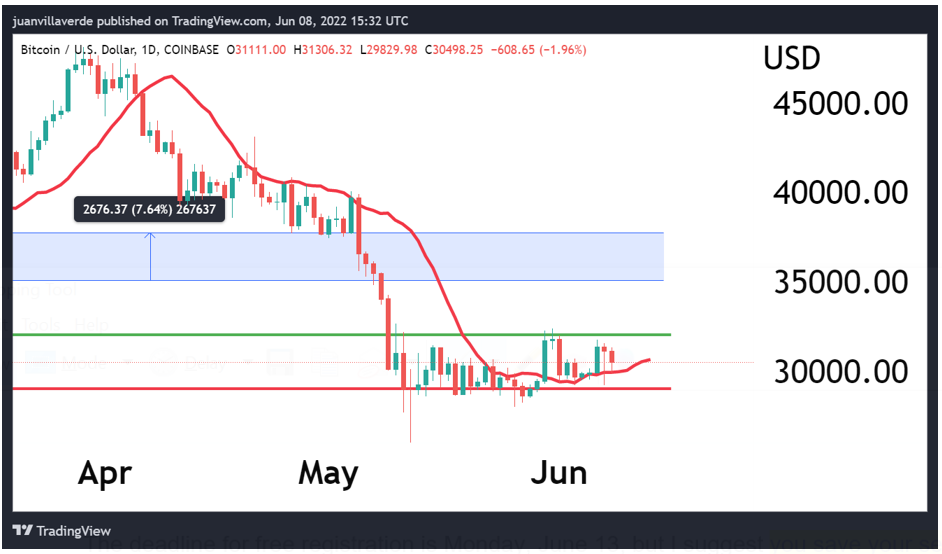Regulatory Efforts Pale in Comparison to Inflation’s Influence on the Market
 |
| By Alex Benfield |
Investors are suffering from tunnel vision. No amount of positive news can turn their attention away from the runaway inflation we're experiencing … or the Federal Reserve's hawkish plan to stop it.
With this crisis now about to accelerate, Weiss Ratings founder Dr. Martin Weiss will be holding a series of three emergency briefings starting next week, exclusively for members. He'll map out what's likely to happen next, recommend seven urgent steps for portfolio protection and reveal a breakthrough strategy for profit in times of crisis.
The deadline for free registration is Monday, June 13, but I suggest you save your seat now.
The timing of these briefings couldn't be better because we're starting to see just how strong inflation's influence over crypto is.
Over the past few days, Bitcoin (BTC, Tech/Adoption Grade "A-") has attempted to break out multiple times … only to fall back down to where it started.
This isn't too surprising. We've mentioned repeatedly that the current primary driver of this market is the Federal Reserve and its plan to fight inflation.
Ideally, the actions of the Fed would have little to no impact on crypto. That's one of the main reasons Satoshi Nakamoto created Bitcoin in the wake of the 2008 financial crisis. The problem is that crypto is still too new and not yet widespread enough to stand completely on its own.
Until that happens, inflation — and by extension, the Fed's decisions to curb it — will still have an impact on cryptocurrencies. In fact, it has so much influence that a recent attempt at regulation had almost no impact on the broad market.
Yesterday Senators Cynthia Lummis (R-WY) and Kirsten Gillibrand (D-NY) released a crypto bill that would label Bitcoin, Ethereum (ETH, Tech/adoption Grade "A") and most other popular cryptocurrencies as commodities to be put under the regulative authority of the Commodity Futures Trading Commission (CFTC) .
Previously, there had been talks of considering cryptocurrencies as securities rather than commodities. The bright side of this is that it would seemingly throw a wrench in Securities and Exchange Commission (SEC) Chair Gary Gensler's planned assault on this industry. That alone is bullish news.
But, as I said, this had little effect on the market, confirming that the only thing investors are concerned with is quantitative tightening (QT) and rising interest rates.
The inflation problem is simply too big to ignore, and it's starting impact everyday life more noticeably.
The national average gas price is sitting at just under $5 a gallon — a record high — and the prices of groceries are rising just as fast. The Fed has realized that it must act tough this time around and curb inflation before this problem gets out of hand.
But here's the secret we already know: Inflation is already out of its control.
The Fed can, and likely will, continue to raise interest rates throughout the rest of 2022, perhaps raising the effective rate to as high as 3%. That would be a huge change from the near-zero rates we saw just last year … but still nowhere near enough to combat inflation that's measuring at around 8%.
In other words, the Fed can't raise rates high enough or fast enough to actually combat inflation, especially not while trying to manage a "soft landing" — i.e., without putting massive strain on the markets.
This is the new norm, a reality that many Americans never thought possible. We'll likely have to live with high inflation for years as a direct consequence of our wild monetary system.
As I mentioned earlier, Bitcoin was created to be a lifeboat, offering an escape from this very system. At some point in the near future, Bitcoin's "inflation hedge" narrative will truly be tested.
Will money flee from evaporating savings accounts and gut-punched stock portfolios and rush into crypto markets? We think so, but that will take time … and likely more financial pain before investors wake up to the reality that they're operating in a failed monetary system.
And Bitcoin will be waiting for those investors when they do..
Until then, Bitcoin investors still have worries of their own. The bulls and bears have been battling over the $30,000 inflection point for weeks, with neither side able to build up enough momentum for a rally or fall.
Bitcoin has climbed back above its moving average, which indicates that the bulls do have a slight advantage — at least in the short term. They'll need to push BTC back and hold above $32,000 in the coming days to lock in that momentum before they can set their sights on the next important resistance level near $36,000.
Here's BTC in U.S. dollar terms via Coinbase Global (COIN):
Notable News, Notes and Tweets:
- Blockworks breaks down crypto's very eventful past 24 hours.
- At least U.S. Treasury Secretary Janet Yellen doesn't think inflation will last 10 more years …
- Michael Saylor offers a daily reminder that Bitcoin is the solution to our troubles.
What's Next
In the face of out-of-control inflation and the Fed's response to it, bulls have struggled to gain any sustained momentum.
And that pattern is likely to continue, even with positive developments such as increased institutional adoption, potential smart regulation and even the upcoming Ethereum Merge event.
Now that's not to say that we won't see any rally at all. In fact, we're still expecting some sort of move upward in the near future. However, that rally will likely be short-lived, perhaps even just a quick bull trap.
As always, we'll be monitoring that situation closely.
Best,
Alex


